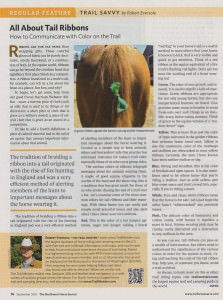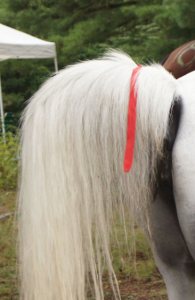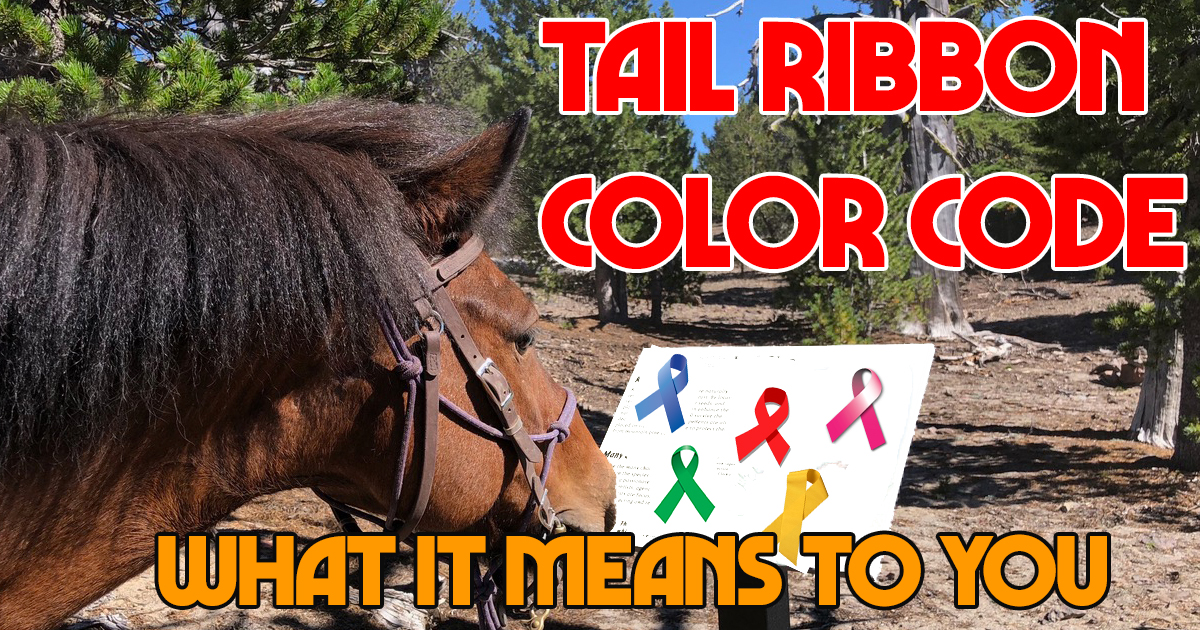 Horse Tail Ribbon Color Code
Horse Tail Ribbon Color Code
As Published in The Northwest Horse Source, September 2015
Ribbons are for more than wrapping gifts. These colorful pieces of fabric can be purely decorative, utterly functional, or a combination of both. For us in the equine world ribbons can go far beyond the cerulean hued that signifies a first place finish in a competition. A ribbon found tied to a horse’s tail can tell us a lot about the beast at a glance. But why?
From our good friend Merriam Webster:
 Ribbon – noun
Ribbon – noun
: a narrow piece of cloth (such as silk) that is used to tie things or for decoration
: a short piece of cloth that is given as a military award
: a piece of colored cloth that is given as an award in a competition
I’ll add a fourth definition. : a piece of colored material tied to the tail of an equine that conveys important information about that animal.
The tradition of braiding a ribbon into a tail originated with the rise of fox hunting in England and was a very efficient method of alerting members of the hunt to important messages about the horse wearing it. Created as a simple and safe way of keeping animals, riders, and bystanders’ safe this practice has continued relevance for todays’ trail rider, especially those of us that enjoy group rides.
The various colors of ribbons telegraph different messages about the animals wearing them. Long a staple of commonly known equine etiquette in the worlds of the hunt and the show ring, this is a tradition that has great merit for those of us that choose to chase the end of the trail, instead of a fox, and explore the boundless outdoors.
Let’s examine some of the most common colors for tail ribbons and their meanings. With these basics you’ll have an easy way to avoid potential issues and also alert other riders about your animals.
 Red is known as the color of temper, agitation, anger, and danger. Adding a literal “red flag” to your horse’s tail is a useful method to warn others that your horse is known to kick. Red is very visible and quick to get attention. Think of a red ribbon as the equine equivalent of a fire truck’s flashing red lights. Don’t get too near the working end of a beast wearing red.
Red is known as the color of temper, agitation, anger, and danger. Adding a literal “red flag” to your horse’s tail is a useful method to warn others that your horse is known to kick. Red is very visible and quick to get attention. Think of a red ribbon as the equine equivalent of a fire truck’s flashing red lights. Don’t get too near the working end of a beast wearing red.
 Green, the color of new growth and renewal is used to signify a lack of experience. Green ribbons are appropriate for not only young horses, but also those that have too few trail miles under their hooves. Give green some room to breathe lest the kiddo freaks out over an invisible scary horse-eating monster. Think of green as the equine version of a “student driver” sign.
Green, the color of new growth and renewal is used to signify a lack of experience. Green ribbons are appropriate for not only young horses, but also those that have too few trail miles under their hooves. Give green some room to breathe lest the kiddo freaks out over an invisible scary horse-eating monster. Think of green as the equine version of a “student driver” sign.
 Yellow, more than just the color of hope mirrored in the golden ribbons that welcome home loved ones. Yellow is also the cautionary color of the roadways. Stallions are often asked to wear ribbons of yellow although the stallions I have known have been neither of the mellow strain nor of the bellied variety.
Yellow, more than just the color of hope mirrored in the golden ribbons that welcome home loved ones. Yellow is also the cautionary color of the roadways. Stallions are often asked to wear ribbons of yellow although the stallions I have known have been neither of the mellow strain nor of the bellied variety.
 Blue is strong and steadfast. The color of freedom and open spaces is also sometimes used to let others know that you’re riding a stallion. Just as with yellow, give blue some space and don’t crowd him, especially if you’re riding a mare.
Blue is strong and steadfast. The color of freedom and open spaces is also sometimes used to let others know that you’re riding a stallion. Just as with yellow, give blue some space and don’t crowd him, especially if you’re riding a mare.
 White is pure and clean. Ribbons of white mean that the horse is for sale. Let’s just hope that the seller hasn’t “whitewashed” any potential issues.
White is pure and clean. Ribbons of white mean that the horse is for sale. Let’s just hope that the seller hasn’t “whitewashed” any potential issues.
 Pink is the delicate color of femininity, cotton candy, and mares in heat. Horses wearing pink may be cranky, easily distracted and a distraction to stallions in the area.
Pink is the delicate color of femininity, cotton candy, and mares in heat. Horses wearing pink may be cranky, easily distracted and a distraction to stallions in the area.
As we’ve seen, the horse tail ribbon color code can pass on a wealth of information. But riders need to understand the significance of the various colors in order for the system to work. Using and teaching the code of the tail ribbon may just help you avoid a trail accident.
As always for more information on this or other trail riding topics visit www.trailmeister.com the largest equine trail and camping guide in the world.


